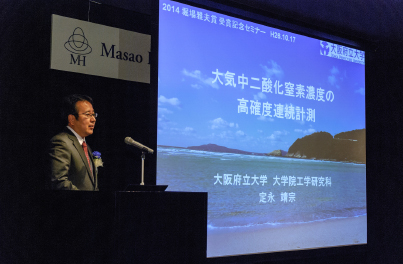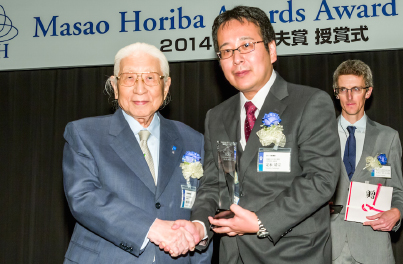

Continuous concentration measurements of nitrogen dioxide in the atmosphere with high accuracy
Dept. of Applied Chemistry, Graduate School of Engineering, Osaka Prefecture University
*The organization and the title are those when awarded
Abstract
- 日本語
- English
二酸化窒素(NO2)は環境基準値が設けられている主要な大気汚染物質の一つであるが、現在NO2のモニタリングで広く用いられているオゾン化学発光法ではNO2濃度を過大評価することが知られている。一方、現在の高確度なNO2測定技術では、光軸調整など高い技術を必要とする。モニタリング装置として広く用いられるには、高確度であることだけでなく、連続測定可能でかつ高いメンテナンス技術を要さないことも必要である。本研究では、発光ダイオードを用いたNO2濃度を高確度でモニタリング可能な装置を二種類開発したので報告する。
Nitrogen Dioxide (NO2) is one of the major atmospheric pollutants and many countries set an air quality standard for NO2. However, an ozone chemiluminescence method, which is widely used for current NO2 monitoring, overestimates NO2 concentrations. On the other hand, current NO2 measurement techniques with high accuracy require high operational techniques such as optical alignment. In order to be widely used as monitoring instruments, the following two points as well as high accuracy are required. First, NO2 can be observed continuously. Second, high operational techniques are not required. In this research, two kinds of atmospheric NO2 monitoring instruments with high accuracy have been developed and the details of the instruments are reported in this article.
Research summary
Concentrations of atmospheric NO2 are monitored by a chemiluminescence detection technique (CLD*1). NO2 is converted to NO by the converter*2 and then the NO is detected by the CLD.
In order to monitor NO2 concentrations more accurately, Dr. Sadanaga developed two instruments based on a selective photolytic NO2 converter to NO using UV light emitting diodes (LEDs) and a light emitting diode induced fluorescence technique (LED-IF*3). Dr. Sadanaga is also performed long-term continuous monitoring of NO2 using the instrument for practical use.
The NO2 monitoring systems with high accuracy are expected to clarify the chemical mechanisms of gaseous components in the atmosphere such as ozone and acid species.
*1) The method to obtain NO concentrations by measuring light intensity emitted by the reaction of NO with O3.
*2) The unit for converting NO2 into NO.
*3) The method to obtain NO2 concentrations by measuring light intensity emitted from excited NO2 molecules. The excited NO2 molecules are formed by irradiating NO2 molecules with a blue LED light.



